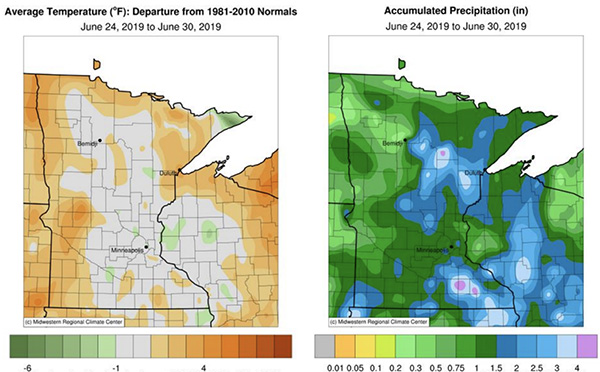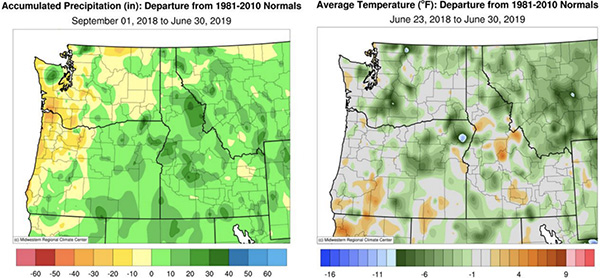Thanks to favorable weather conditions, growers in Michigan were able to make significant progress on the seeding of their bean crop last week. In the other key states, the pulse crops have been planted and are starting to bloom. Overall, the crop remains behind the five-year average due to the delays caused by wet weather during the planting season.
Michigan
Michigan is a major black bean growing state. This planting season, cool temperatures and rain delays have slowed dry bean sowing considerably, but last week saw warmer weather and brought relief from the rain. Growers took advantage of the 4.2 days that were suitable for fieldwork and moved the needle on dry bean planting progress to 65%, up from 31% the previous week, but still behind the five-year average of 92%. Crop emergence was at 25%, also behind the five-year average of 79%.
Minnesota
Minnesota, a key kidney bean growing state, has enjoyed favorable weather recently. Last week, 4.1 days were suitable for fieldwork. Topsoil moisture was 96% adequate to surplus, and subsoil moisture was 97% adequate to surplus. Temperatures were above normal last week, and that helped push the crop along. Dry bean emergence was at 96%, a week behind the five-year average of 99%, with reports of some blooming taking place. Most of the crop was rated fair (29%) to good (53%), with 15% rated excellent.

Montana
Montana is a major producer of pulse crops. Last week, there were 4.5 days suitable for fieldwork, but below-average temperatures and scattered rains hampered crop progress. Topsoil moisture was rated 85% adequate to surplus. Subsoil moisture was rated 78% adequate to surplus. Dry pea emergence was at 97%, with 45% of the plants blooming (behind the five-year average of 73%). The crop rated 11% very poor to poor, 44% fair, 43% good and 2% excellent. Lentil crop emergence was also at 97%, with 33% of the plants blooming (behind the five-year average of 58%). The crop rated 3% poor, 50% fair, 45% good and 2% excellent. The dry bean crop (including chickpeas) was 93% emerged, slightly ahead of the five-year average of 90%.
North Dakota
North Dakota is the country’s top dry bean producing state. Last week, 5.3 days were suitable for fieldwork. Top- and subsoil moisture levels were rated 85% and 78% adequate to surplus, respectively. Dry pea crop emergence was at 96%, with 30% of the plants blooming, behind the five-year average of 65%. The crop condition rating was 4% poor, 17% fair, 74% good and 5% excellent. Dry bean crop emergence was at 97%, with 1% of the plants blooming. The crop condition rating was 1% poor, 18% fair, 69% good and 12% excellent.
Pacific Northwest
The Pacific Northwest is an important pulse producing region. Last week, the region received favorable weather across the board, with 6.6 days suitable for fieldwork in Idaho, 6.3 in Oregon and 6.6 in Washington. In Idaho, 92% of the bean crop had emerged, slightly behind the five-year average of 94%. The crop rated 46% fair, 52% good and 2% excellent. Idaho’s dry pea crop rated 49% fair, 49% good and 2% excellent. In Oregon, dry bean crop emergence was 99%. The dry bean crop rated 8% very poor to poor, 16% fair, 64% good and 12% excellent. Oregon’s dry pea crop rated 4% very poor, 17% poor, 21% fair, 40% good and 18% excellent. In Washington, 97% of the dry pea crop had emerged. The crop rated 1% poor, 10% fair, 83% good and 6% excellent. Washington’s dry bean crop rated 12% fair, 87% good and 1% excellent.

Disclaimer: The opinions or views expressed in this publication are those of the authors or quoted persons. They do not purport to reflect the opinions or views of the Global Pulse Confederation or its members.